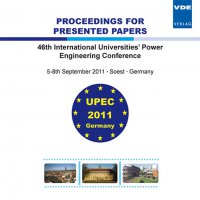Impact of induction machine based wind generation on power system voltage and oscillatory stability
Konferenz: UPEC 2011 - 46th International Universities' Power Engineering Conference
05.09.2011 - 08.09.2011 in Soest, Germany
Tagungsband: UPEC 2011
Seiten: 5Sprache: EnglischTyp: PDF
Persönliche VDE-Mitglieder erhalten auf diesen Artikel 10% Rabatt
Autoren:
Xia, Jun; Dy?ko, Adam (University of Strathclyde, UK)
O'Reilly, John (University of Glasgow, UK)
Inhalt:
With fast development of wind energy in the world, the influence of wind farms on power system stability and control is increasing. Some European countries, such as Germany and Denmark, have already reached the level of wind generation where there is an increased potential for system instability. This paper is aimed to analyze how increasing levels of induction machine based wind generation can impact on voltage and oscillatory stability of the system. A fragment of the existing 132kV network in the South-West part of Scotland has been selected for this study as an example of relatively weak sub-transmission type system. The potential impact of wind generation is studied by including varying amounts of induction generation linked to the model network by a relatively long line representing an offshore wind farm connection. Initially, through the load flow studies the voltage level is assessed which will leads to the design of the reactive power compensator. An SVC model is subsequently included and linear models for a number of different scenarios are created. The damping coefficients and frequencies of the system oscillatory modes are analyzed in order to establish the impact of the application of the SVC. Following the eigenvalue analysis the need and the design of a damping controller is presented. The effects of SVC connection and effectiveness of the designed controller is assessed using frequency response Bode plots. Based on the simulation results the paper draws a number of practical observations regarding the connection of fixed-speed induction machine based wind generation to the existing power systems (especially in remote areas where the network is weak). The need for further modeling work to include other types of generating technologies is also emphasized.


